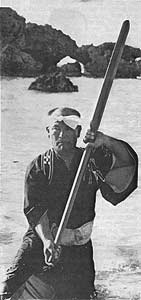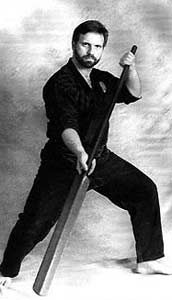A Philosophy of Peace Taught Through An Ancient Weapon
- Seiyu Oyata and the Ryukyuan Eku
By Bill Gossett
 |
Taika Seiyu Oyata uses an eku
on a beach on Okinawa. |
The sun bearing down on the bare backs of the boat rowers
highlights the muscle definition in their upper bodies. They strain for
speed to pass their opponents' boat, rowing equal and within an arm's
distance. The rowers move as one as they press the ocean water behind
them into the wake. The fronts of both boats cut a line through the ocean
water gliding toward the same goal with wanton determination. A rippling
ocean surface flashes white sun behind the boats as they draw closer to
the finish point near the shore. The glare of white light flashing off
the water causes the villagers on shore, who came to watch the ancient
race, to squint as their bodies bob and weave in the sand to position
themselves for a better view of the finish.
This ancient Ryukyuan (Okinawan) ritual is a race that is held every
year between two villages and both sides spend the entire year anticipating
the event so they can celebrate their victory over the other village.
The villagers will tell stories about the exploits of the event for decades
to come as their traditions dictate. As the two boats come closer to the
finish line, two representatives, one from each village, watch the boats
intensely to determine a winner. The spectators cheer their team on. The
rowers on both teams frantically slap their eku (boat oars) in the water
as they approach the last few feet of the race. The two judges jump in
the air clapping their hands as the two boats cross the finish line and
the entire crowd of spectators yell and applaud enthusiastically, both
sides claiming victory. Both teams of competitors hop out of their boats
jumping up and down and congratulating their team-mates on a hard fought
victory.
Suddenly the eyes of the opponents meet in the middle of victory celebrations
and they become quiet as quickly as they had begun to celebrate. They
realize the judges are heatedly arguing over who the actual winner of
the race was. The two teams rush over to the representatives simultaneously
and listen intently for about 30 seconds, as the debate intensifies. The
morning sun is making the sand on the beach hot. The shouting of the two
representatives grows in pitch and the two rowing teams begin to shout
at each other. Suddenly, fists begin to fly, bodies begin to roll in the
sand, clinging and swinging at one another and an all-out free-for-all
begins.
Quietly and quickly an older gentleman steps out of the crowd and picks
up an eku lying near the confusing altercation. With relative ease, the
gentleman moves into the centre of the uncontrolled mass. The eku appears
to move but then disappears, and all that can be seen is a whirlwind cloud
of sand. The eku and the elderly gentleman appear in the cloud of sand
as a silent silhouette. The eku gently trips a rower and several bodies
fall over the hunched figure. Within a few moments the heavy cloud starts
to settle and all that is left is a lingering hint of light dust in the
air. The man had used the eku to throw sand at the rowers engaged in the
fight, all of whom were disabled and lying either on the ground, coughing
and gagging, or walking blindly around, rubbing their eyes and violently
shaking the sand from their mouths, noses and eyes. The fight was over
and there were no casualties. The elderly gentleman moves quietly away,
tapping the eku in the sand as he walks.
Taika Seiyu Oyata, a 10th-degree black belt and 79-years-old Okinawan
Grand Master, teaches the ancient art of the Ryukyuan eku out of his international
headquarters in Independence, Missouri, U.S.A. Taika Oyata (Taika' is
an honorific title, in the same vein as 'Shihan') studied the art of the
Ryukyuan eku under a retired bushi named Uhugushiku No Tan Mei, then in
his nineties. Uhugushiku's best friend was another master of Chinese descent,
and of similar age, named Wakinaguri No Tan Mei, and the young Oyata studied
under him as well.
Uhugushiku was a battle veteran with traditional Ryukyuan weapons and
held the ancient secrets of tuite jitsu (grappling art), atemi jitsu (nerve
strikes to the limbs) and kyusho jitsu (nerve strikes to the head, neck
and torso) inherent within Ryukyu Kempo. Wakinaguri had chosen to retain
and study his family's art of Chinese nerve strikes and is said to have
practiced fingertip strikes straight into ocean coral for so many years
that his fingers had all been worn down until they were even! Uhugushiku
and Wakinaguri trained together for many, many years and, as they got
older, became inseparable.
Taika Oyata is the only living heir to the Uhugushiku family system of
Ryukyu Kempo. The ancient art of kyusho jitsu that Uhugushiku taught includes
the very secret touch strike to the neck area, delivery of which causes
a would-be attacker to crumble in a sleep-like state to the ground...to
remain so until revived. This touch strike can also be used to kill; however,
it is used better as a warning that worse could follow. Taika Oyata is
the only man alive in the world today to have received this information
from Uhugushiku and who can actually perform the techniques correctly.
The story of the rowing contest and the altercation that transpired is
one of the explanations of the origins of the eku as a Ryukyuan weapon.
In this particular incident it is noteworthy that no-one was injured permanently.
The story leans toward the idea that the wielder of the weapon knew of
its immense power to disable permanently or kill, and he merely chose
not to do so.
The Ancient Ryukyuan eku kata that Taika Oyata teaches are very sophisticated;
not only are they difficult to learn and perform properly, but the techniques
used in real situations are also very difficult to apply. The eku kata
bunkai (kata interpretation) is also steeped in the ancient secrets of
the Uhugushiku system, the emphasis of which is actual battle theory and
application.
Photo 2
Caption: Shihan Bill Gossett is a student of Master Oyata
 |
Shihan Bill Gossett is a student
of Master Oyata. |
Two of the eku kata that Taika Oyata teaches are the 'Bushi Matsumura
eku no kata' that originates from the village of Shuri, and the 'Bushi
Machimura eku no kata' from the village of Tomari. It is believed that
these two villages are possibly the two that had rowing competitions and
ultimately resulted in the story of the fighting rowing teams and the
emergence of the eku as a sophisticated Ryukyuan weapon.
Taika Oyata also shows the power of his ancient technique in the complex
form of 'Oyata Shin Shu Ho Ryu', best displayed in the kata 'Shi Ho Ha
Po No Te'. The relaxed, gentle power of Taika Oyata and his philosophy
of life synthesise themselves and reveal the ancient traditions of his
life-protection art in this kata. The use of 'Shin Shu Ho' as an art form
that protects not only the victim, but the assailant's life, is a major
theme of Taika Oyata's philosophy. This philosophy on life harnessing
itself within such a formidable art form is an extrapolation of what the
authentic ancient Ryukyuan warrior pursued.
The elderly man with the eku at the beach best exemplifies the life protection
art of Taika Oyata. Upon stopping the two rowing teams from fighting,
without injuring any of them, he quietly and calmly moves away, lightly
placing the eku in the sand as he walks. Hopefully that imprint in the
sand will stay with us as practitioners of the martial arts.
Note: This article first appeared
in "Terry O'Neill's Fighting Arts International" No. 90 1995
and is posted with permission of the author.
About The Author:
Bill Gossett as has a B.A. in Philosophy, M.A. in East Asian Language
and Cultures with emphasis in Japanese language and Ph.D Ancient East
Asian Studies (presently completing). During 1987-1988 he served as Adj.
professor in East Asian Cultures and Martial Arts at William Jewell College,
Liberty, MO. He is a nationally an internationally published author on
East Asian cultures and martial arts. Gossett began study and training
in East Asian martial arts in 1967 at the age of 9. His expertise include
Ryukyu Kempo, Ryu Te, Ryukyu Kobudo (ancient Ryukyuan weaponry), Oyata
Shin Shu Ho, Tuite Jitsu, Kyusho Jitsu, Atemi Jitsu, Judo, Jiu Jitsu,
Bogu Kumite, Iaido, Ken Jitsu, and ancient Chinese weaponry. He is a long
time personal student of Taika Seiyu Oyata, 1982 to present. Founder of
Ryukyu Kempo, Ryu Te, and Oyata Shin Shu Ho in America. Koubushi, Gossett
resides 15 minutes from Taika Oyata's home and headquarters dojo, 1982
to present. He has traveled with Taika Oyata since 1982 to various demonstrations
and instruction with the ancient Ryukyuan eku. For more information see:
http://ryukyueastasianmartialarts.com.
He can be reached at:
info (at) ryukyueastasianmartialarts (dot) com
|